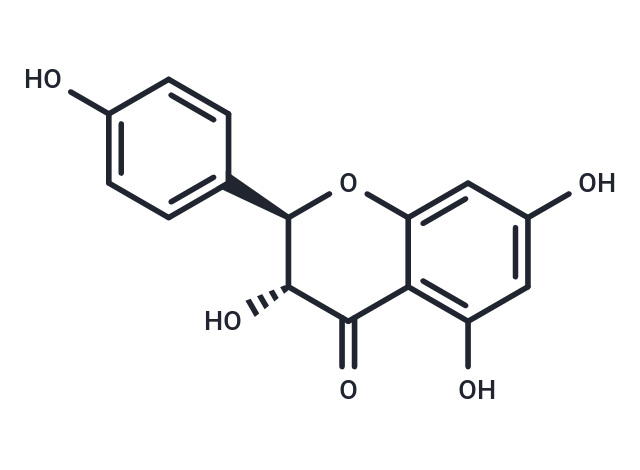Shopping Cart
- Remove All
 Your shopping cart is currently empty
Your shopping cart is currently empty

Dihydrokaempferol (Aromadendrin) is a natural product. It induces apoptosis and inhibits Bcl-2 and Bcl-xL expression, possesses anti-inflammatory, antioxidant, and anti-diabetic properties, it exhibits anti-inflammatory activity

| Pack Size | Price | Availability | Quantity |
|---|---|---|---|
| 1 mg | $56 | In Stock | |
| 5 mg | $122 | In Stock | |
| 10 mg | $196 | In Stock | |
| 25 mg | $372 | In Stock | |
| 50 mg | $549 | In Stock | |
| 1 mL x 10 mM (in DMSO) | $119 | In Stock |
| Description | Dihydrokaempferol (Aromadendrin) is a natural product. It induces apoptosis and inhibits Bcl-2 and Bcl-xL expression, possesses anti-inflammatory, antioxidant, and anti-diabetic properties, it exhibits anti-inflammatory activity |
| In vitro | Aromadendrin, a flavonol, has been reported to possess a variety of pharmacological activities such as anti-inflammatory, antioxidant, and anti-diabetic properties.?Aromadendrin significantly suppressed LPS-induced excessive production of pro-inflammatory mediators such as nitric oxide (NO) and PGE2.?In accordance, aromadendrin attenuated LPSinduced overexpression iNOS and COX-2.?In addition, aromadendrin significantly suppressed LPS-induced degradation of IκB, which sequesters NF-κB in cytoplasm, consequently inhibiting the nuclear translocation of pro-inflammatory transcription factor NF- κB.?Aromadendrin significantly attenuated LPS-induced activation of JNK, but not ERK and p38, in a concentration-dependent manner.?Aromadendrin exhibits anti-inflammatory activity through the suppression of nuclear translocation of NF-κB and phosphorylation of JNK in LPS-stimulated RAW 264.7 macrophage cells[2]. |
| Alias | Aromadendrin |
| Molecular Weight | 288.25 |
| Formula | C15H12O6 |
| Cas No. | 480-20-6 |
| Smiles | O[C@@H]1[C@H](Oc2cc(O)cc(O)c2C1=O)c1ccc(O)cc1 |
| Relative Density. | 1.599 g/cm3 (Predicted) |
| Storage | Powder: -20°C for 3 years | In solvent: -80°C for 1 year | Shipping with blue ice. | |||||||||||||||||||||||||||||||||||
| Solubility Information | H2O: < 0.1 mg/mL (insoluble) DMSO: 120 mg/mL (416.31 mM), Sonication is recommended. | |||||||||||||||||||||||||||||||||||
Solution Preparation Table | ||||||||||||||||||||||||||||||||||||
DMSO
| ||||||||||||||||||||||||||||||||||||

Copyright © 2015-2025 TargetMol Chemicals Inc. All Rights Reserved.